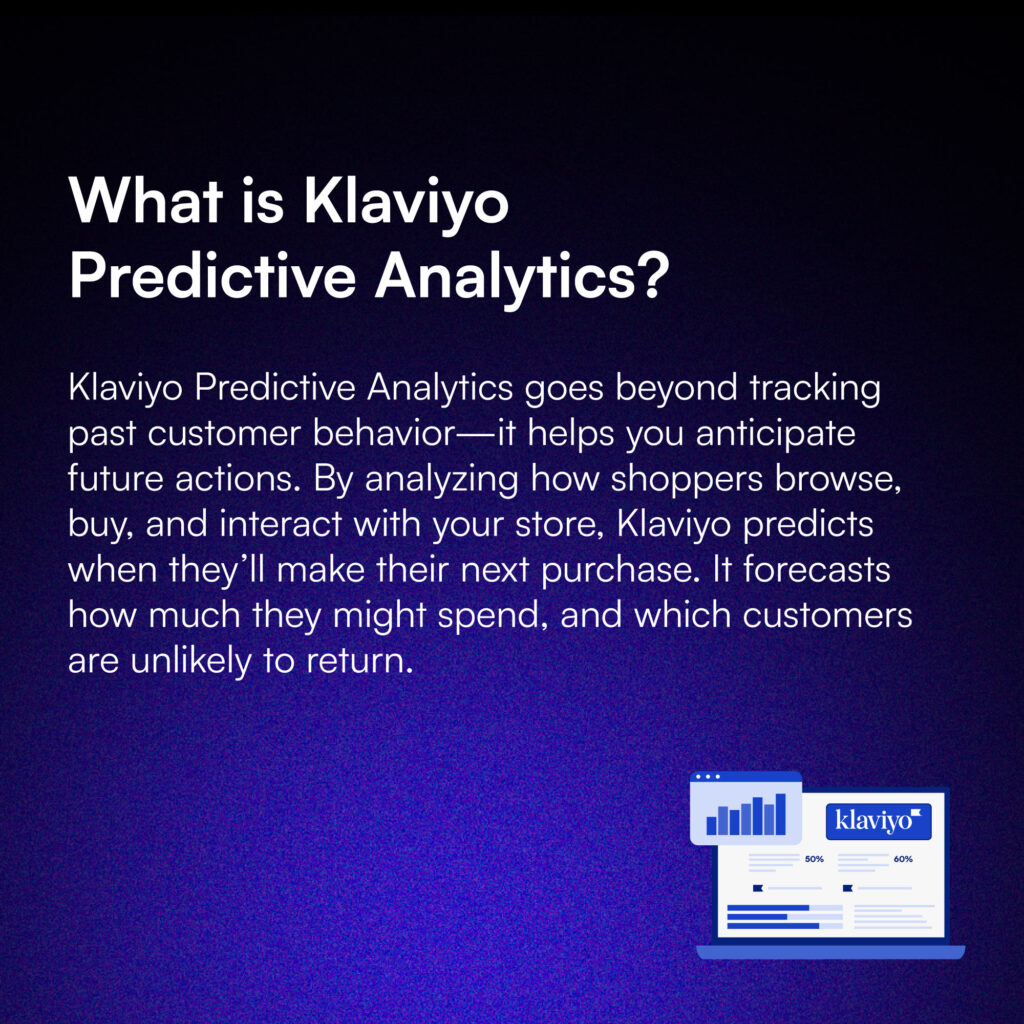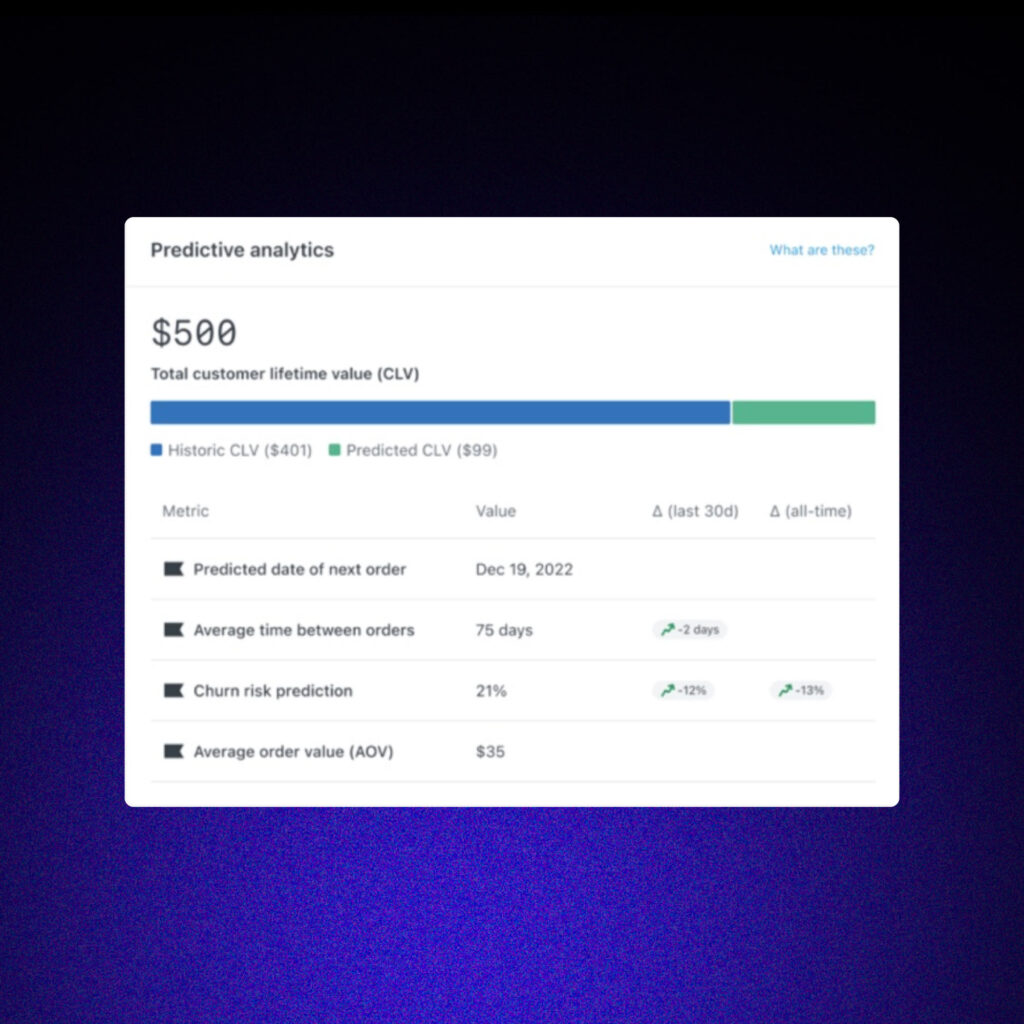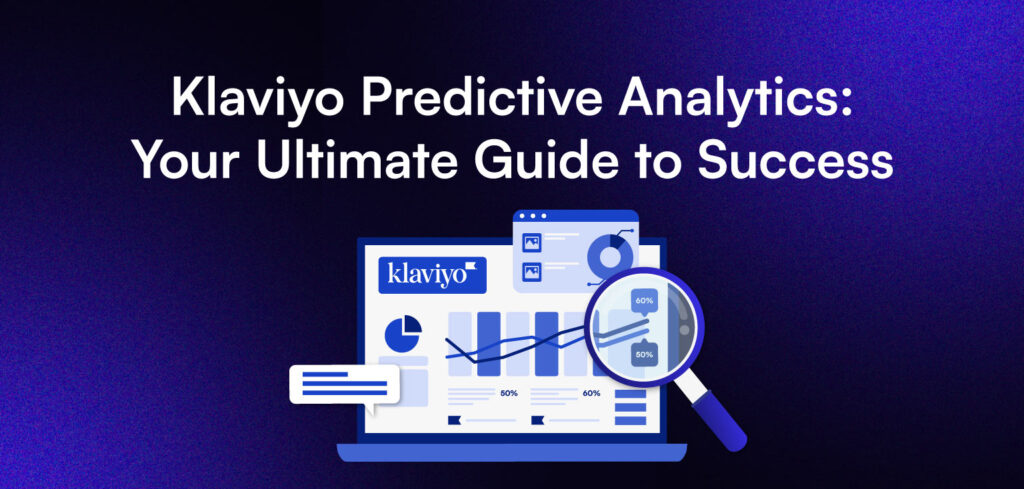What if you could predict exactly when a customer will make their next purchase, or how much they’re likely to spend over the next year?
Imagine the impact that kind of insight could have on your marketing strategy. You’d know who to target when to reach out, and what offers would be most effective.
That’s exactly what Klaviyo Predictive Analytics helps you do.
Instead of making marketing decisions based on gut feelings or outdated data, you get access to AI-powered predictions based on real customer behavior. With insights like Predicted Customer Lifetime Value (CLV) and churn risk analysis, you can build smarter and more effective campaigns.
In this guide, we’ll break down how Klaviyo’s predictive analytics works, what key metrics to pay attention to, and how you can use this data to grow your business.
How Does Klaviyo Predictive Analytics Actually Work?

For e-commerce brands, good timing makes all the difference. Well-timed emails mean more sales and less guesswork. Plus, smart discounts and a focused strategy help you reach the right people instead of wasting effort.
Here’s how it works:
Step 1: Collecting and Analyzing Customer Data
Klaviyo gathers data from multiple touchpoints across your store, including:
1. Order history – How often do customers buy, and what products do they prefer?
2. Cart activity – Do they add items but abandon their cart?
3. Browsing behavior – Are they checking out certain product pages multiple times?
4. Email & SMS engagement – Do they open, click, or ignore your messages?
All this information helps Klaviyo spot trends and understand each customer’s unique shopping habits.
Step 2: Predicting Customer Behavior
Once Klaviyo processes the data, it generates insights to help you answer key questions like:
- Which customers are likely to buy again? – Some shoppers will return regularly, while others might need a nudge.
- Who is at risk of churning? – If a customer usually orders every 30 days but hasn’t returned in 60, they might need a re-engagement campaign.
- When will a customer likely make their next purchase? – This helps you send promotional emails right when they’re ready to shop.
- How much will they likely spend? – You can tailor your offers based on a customer’s predicted order value.
Step 3: Using Predictions to Optimize Your Marketing
Once you have these insights, you can create more targeted, personalized campaigns that drive revenue.
Here’s how e-commerce brands can use Klaviyo’s predictions:
1. Win back inactive customers – If Klaviyo flags a shopper as unlikely to return, send winback emails. Send a personalized discount or limited-time offer to reignite their interest.
Example: A customer who previously ordered from your clothing store every three months hasn’t purchased in six. So, you send an email with a “We miss you! Here’s 15% off your next order” offer to bring them back.
2. Increase repeat purchases – If Klaviyo predicts a customer will likely reorder soon, send a reminder email at just the right time.
Example: A shopper who buys protein powder every two months is expected to repurchase soon. You send an email with a “Time for a restock?” subject line and a direct link to buy.
3. Encourage higher spending – If a customer is predicted to spend more, you can upsell or bundle products to increase their order value.
Example: A customer who usually buys sneakers is predicted to spend more next time. Instead of a generic promo, you send an email featuring exclusive sneaker and sock bundles to increase their cart size.
Why Does Using Klaviyo Predictive Analytics Matter?
Without predictive analytics, e-commerce marketing is a guessing game—you send promotions and hope they land at the right time.
With Klaviyo, you can send messages based on when customers are actually ready to buy, leading to:
✅ Higher open and conversion rates – Emails feel relevant instead of random.
✅ Better customer experience – Shoppers get offers they actually care about.
✅ More revenue with less effort – Stop wasting time on untargeted marketing.
For example, if you run a pet supply store and Klaviyo predicts that a dog owner is due for another bag of food in two weeks, you can send them an early reorder reminder with a small discount. This not only increases sales but also makes shopping more convenient for your customers.
At the end of the day, Klaviyo’s predictive analytics gives e-commerce brands a huge advantage—helping you market smarter, sell more, and keep customers coming back.
Predictive Analytics vs. Prescriptive Analytics
Many businesses confuse predictive analytics with prescriptive analytics, but they serve different purposes.
- Predictive analytics forecasts future outcomes based on past data. It helps you understand trends, such as how often customers buy, their average order value, or their likelihood of churning.
- Prescriptive analytics goes a step further by recommending specific actions based on those predictions. Instead of just telling you what might happen, it helps you decide the best course of action.
Example in E-commerce
Imagine you run an online clothing store.
- Predictive analytics identifies that a customer usually buys sneakers every three months and is likely to purchase again within the next 30 days.
- Prescriptive analytics suggests sending them a personalized email with a discount on sneakers or recommending complementary products like socks or shoe care kits to encourage a faster purchase.
While predictive analytics helps you understand what’s coming, prescriptive analytics tells you how to act on that information.
Where to Find Klaviyo’s Predictive Analytics Data
To access Klaviyo predictive analytics, head to the Metrics and Insights tab on a customer’s profile. Here, you’ll find a dedicated section that displays predictive insights, including:
- Historic Customer Lifetime Value (CLV) – The total amount a customer has spent so far.
- Predicted CLV – An estimate of how much a customer will likely spend in the next year.
- Total CLV – The sum of historic CLV and predicted CLV.
- Churn Risk Prediction – The likelihood of a customer churning based on their purchase frequency.
- Average Time Between Orders – The number of days between each purchase.

How Klaviyo Calculates CLV
Klaviyo continuously updates its Customer Lifetime Value (CLV) model using real customer data.
This data is retrained at least once a week to ensure accuracy. If you’re using Klaviyo’s API to send order data, make sure the order value is included in the $value field to generate accurate CLV predictions.
It’s important to remember that predictions are not absolute. Instead, they provide a reasonable estimate based on overall customer trends. While some customers may spend more or less than their Predicted CLV, these figures tend to balance out across large groups.
For example:
If five customers have predicted order values of 1.43, 0.25, 3.12, 0.78, and 2.97, it means that, on average, you can expect around 9 total orders across this group.
How to Use Klaviyo Predictive Analytics to Drive Sales
Now that you understand where to find Klaviyo predictive analytics and how it works, let’s talk about how you can use it to increase sales and retain customers.
1. Segmenting High-Value Customers
Using Predicted CLV, you can create a segment of high-value customers who are expected to spend more in the future.
This lets you:
- Offer exclusive discounts to reward their loyalty.
- Provide VIP treatment, such as early access to sales.
- Tailor personalized recommendations to encourage repeat purchases.
2. Reducing Churn with Targeted Emails
If a customer has a high churn risk, you don’t have to sit back and watch them disappear. Instead, take action by:
- Sending a win-back email with an incentive to bring them back.
- Personalizing offers based on past purchases.
- Running an exclusive limited-time deal to re-engage them.
3. Optimizing Replenishment Flows
If you sell products that customers need to reorder regularly—like skincare, supplements, or pet food—getting the timing right is key.
Predictive analytics can help by automatically sending reminder emails to let customers know when it’s time to repurchase based on their buying habits. This can increase the chances of repeat sales.
However, Klaviyo’s predictive tool doesn’t take into account different replenishment cycles for each type of product. For example, customers may need to buy skincare products sooner than supplements or pet food.
To address this, you can create separate replenishment flows for different product categories. By doing this, each customer will get reminders that fit the specific products they buy, rather than receiving the same reminder for everything.
4. Targeting One-Time Buyers for a Second Purchase
Not all one-time buyers turn into loyal customers, but predictive analytics helps you increase your chances.
You can:
- Create a second-purchase flow that nurtures first-time buyers.
- Offer a discount on their next order to encourage repeat purchases.
- Recommend best-selling products based on their first purchase.
Pros and Cons of Klaviyo Predictive Analytics
Pros
✔ Helps you make data-driven marketing decisions.
✔ Improves customer segmentation for better targeting.
✔ Increases repeat purchases and customer retention.
✔ Optimizes email flows based on predicted behavior.
✔ Allows for better marketing budget allocation.
Cons
❌ Requires a large dataset (at least 500 customers with orders).
❌ Doesn’t factor in specific product types when predicting orders.
❌ Predictions are not 100% accurate for individual customers.
Get the Most Out of Klaviyo Predictive Analytics
If you want to start using Klaviyo Predictive Analytics, make sure you have:
- At least 500 customers who have placed an order.
- An ecommerce integration like Shopify, WooCommerce, or Magento.
- At least 180 days of order history with purchases in the last 30 days.
- Customers who have placed 3+ orders to improve prediction accuracy.
By meeting these criteria, you can unlock powerful predictive insights to take your email marketing strategy to the next level.
No More Guessing
While no prediction is ever 100% perfect, Klaviyo’s predictive analytics gives you a data-driven guide to boost revenue and enhance customer retention.
With insights into future purchase behavior, customer lifetime value (CLV), and churn risk, you can create targeted campaigns that keep your customers engaged and coming back.
If you haven’t started using predictive analytics yet, now is the perfect time. It may not be a crystal ball, but it’s the next best thing—helping you make smarter marketing decisions and drive more sales based on real data, not guesses.


